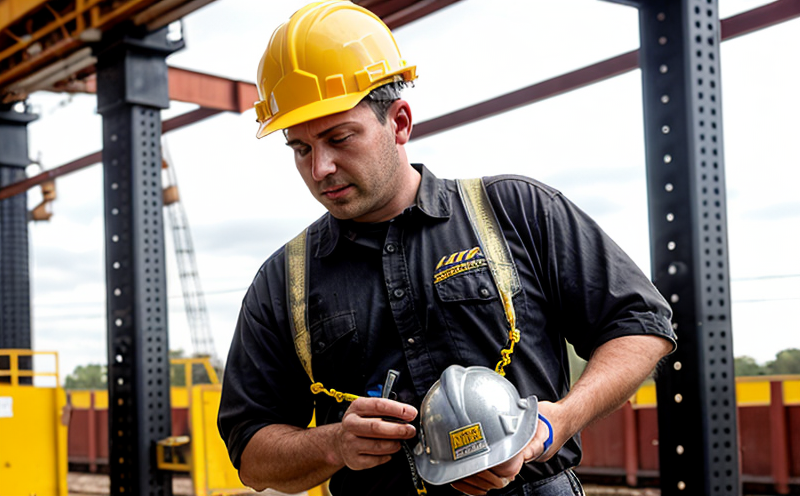Hard hat suspension system inspection
The hard hat is an essential piece of personal protective equipment (PPE) designed to protect workers from head injuries caused by falling objects. The suspension system within the hard hat plays a critical role in ensuring that the helmet provides effective protection.
The primary function of the suspension system is to distribute impact forces across the entire shell of the hard hat, thereby reducing the concentration of force on any one point and minimizing the risk of head injury. This component must be carefully inspected to ensure it meets all relevant standards and performs its intended safety functions correctly.
During an inspection, the integrity and performance of the suspension system are evaluated using a variety of methods tailored to specific standards such as those provided by ASTM F2478-13(2020). This standard outlines detailed requirements for the design, construction, testing, and certification of hard hats with integral suspension systems. Compliance with these standards is mandatory for any manufacturer or supplier aiming to ensure their products meet safety expectations.
The inspection process typically begins with visual examination, where any visible damage or wear is noted. Following this initial check, more rigorous tests may be conducted using specialized equipment designed to simulate real-world conditions under which the hard hat might operate. These tests can include drop tests and static load testing to assess how well the suspension system absorbs and disperses impacts.
Drop tests involve placing a weighted object onto the hard hat from various heights to simulate potential impact scenarios encountered during use. Static load tests measure the maximum force that the suspension system can withstand without compromising its structural integrity. Both types of tests provide crucial insights into the performance characteristics of the suspension system, helping manufacturers identify any areas needing improvement.
Accurate and reliable inspection results are vital for maintaining high standards in workplace safety practices. By adhering strictly to established protocols like those specified by ASTM F2478-13(2020), laboratories can ensure that their findings accurately reflect the true capabilities of hard hat suspension systems, fostering trust among end-users.
In summary, regular inspections of hard hat suspension systems are indispensable for ensuring worker safety. Through meticulous examination and rigorous testing procedures, these assessments help maintain compliance with essential standards while also identifying potential weaknesses that could otherwise lead to compromised protection levels.
Applied Standards
| Standard | Description |
|---|---|
| ASTM F2478-13(2020) | This standard specifies the requirements for integral suspension systems in hard hats, including design criteria, testing procedures, and certification processes. |
Benefits
The benefits of regular inspections extend beyond mere compliance with regulatory requirements. By conducting thorough evaluations of the suspension system within hard hats, organizations can significantly enhance overall worker safety.
One key advantage is improved reliability. Regular inspections help detect early signs of wear and tear that might otherwise go unnoticed until a catastrophic failure occurs. Early identification allows for timely replacements or repairs before incidents happen, thereby reducing risks associated with compromised protection.
Another significant benefit lies in increased confidence among employees. When workers know their protective gear has been rigorously tested and found to meet stringent safety standards, they feel more secure knowing that they are adequately safeguarded against potential hazards.
Moreover, compliance with applicable regulations not only protects individual workers but also contributes positively towards an organization's reputation for maintaining robust safety practices. Demonstrating commitment to worker welfare can foster better relationships between employers and employees, ultimately leading to higher morale and productivity within the workplace.
In conclusion, prioritizing regular inspections of hard hat suspension systems offers numerous advantages that transcend mere regulatory obligations. It promotes safer working environments, enhances employee trust in protective equipment, and supports a culture focused on continuous improvement in safety standards.
Quality and Reliability Assurance
Ensuring the quality and reliability of hard hat suspension systems is crucial for maintaining high standards in workplace safety. Quality assurance measures encompass various aspects aimed at preventing defects, errors, or failures during manufacturing processes and ensuring consistent performance throughout the product lifecycle.
A key aspect of quality assurance involves implementing robust inspection protocols that adhere strictly to established guidelines such as those outlined by ASTM F2478-13(2020). These protocols dictate precise procedures for evaluating different components of the suspension system, including materials used, assembly methods, and final testing outcomes.
Implementing these stringent standards helps guarantee that each hard hat meets specified performance criteria before being released into the market. This commitment to quality not only enhances user confidence but also minimizes risks associated with substandard products.
In addition to manufacturing controls, ongoing monitoring plays a vital role in maintaining reliability over time. Regular field checks and follow-up inspections allow for early detection of any issues arising from prolonged use or environmental factors that could affect the integrity of the suspension system.
By integrating these comprehensive quality assurance practices into daily operations, organizations can establish a strong foundation for sustained excellence in worker protection. This proactive approach fosters trust among end-users and contributes significantly towards creating safer working environments across industries.





